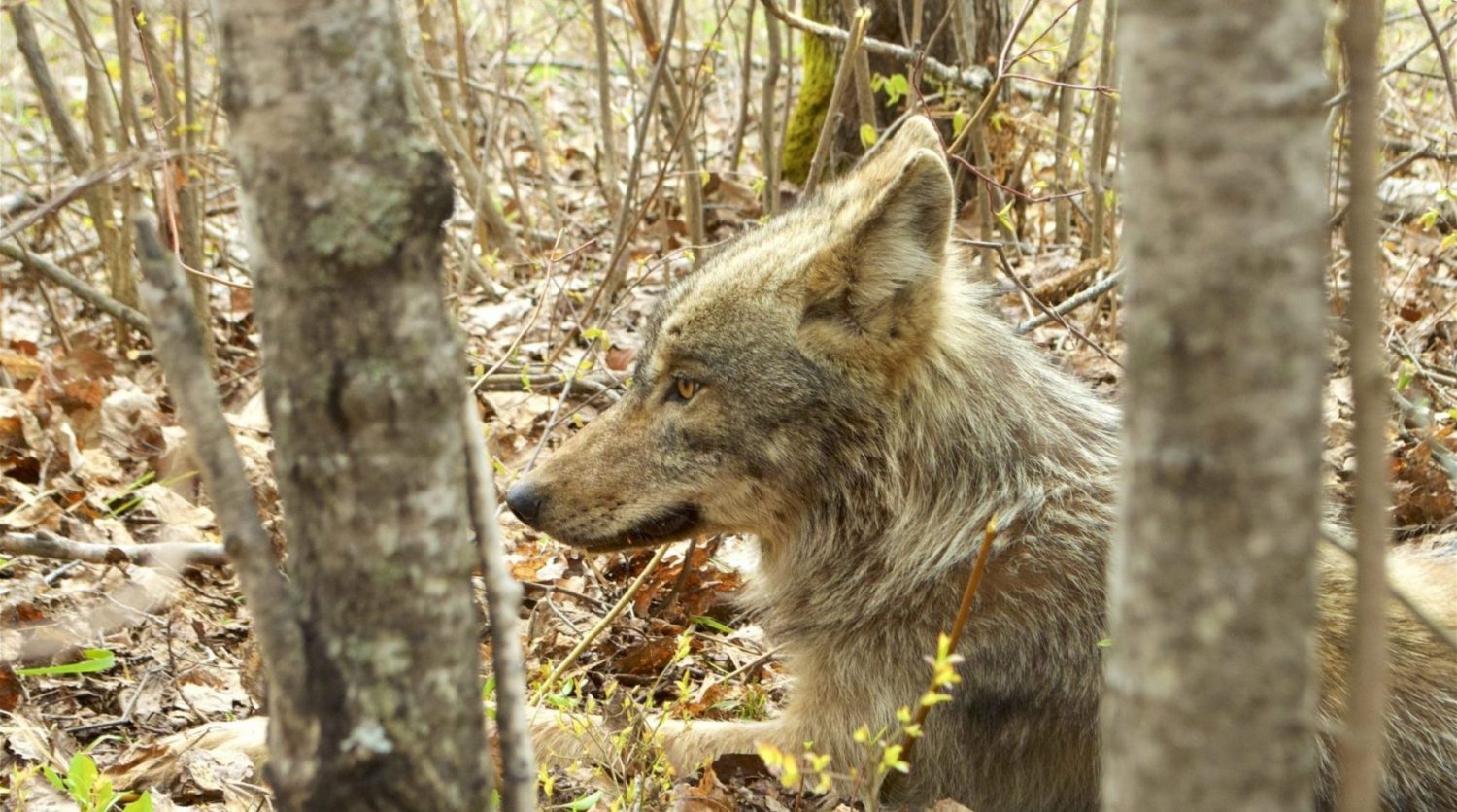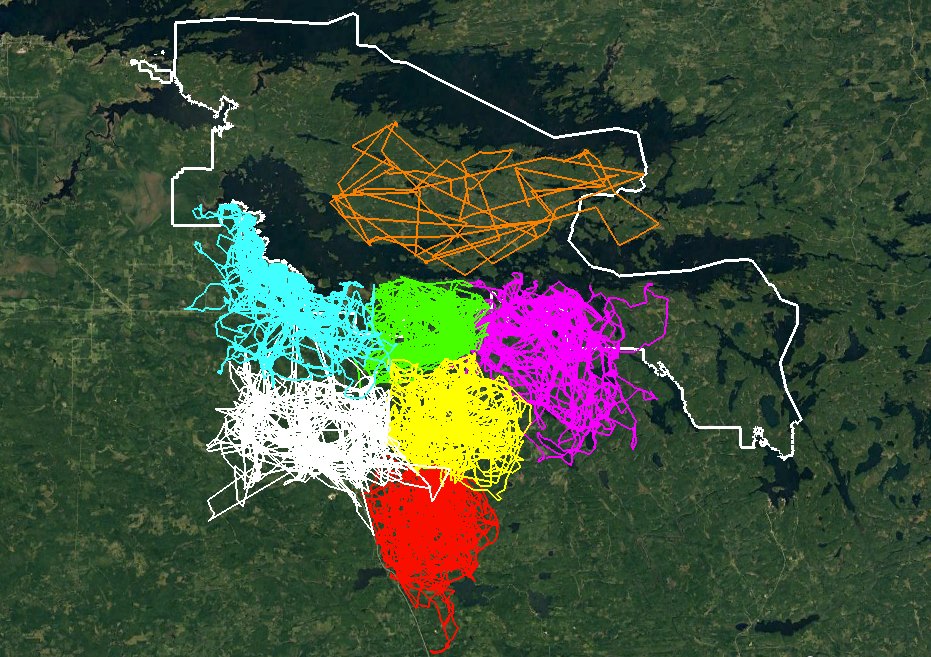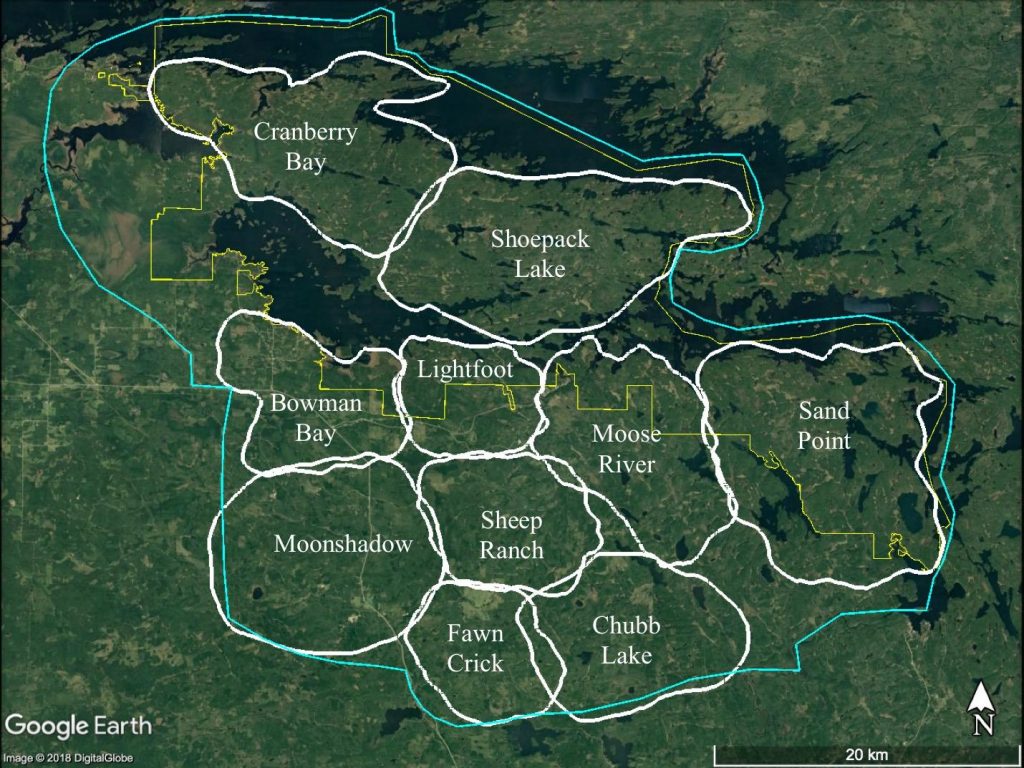
Research Brief: Voyageurs Wolf Project
See the first ever video of wolves hunting freshwater fish near Voyageurs National Park
Published12/13/2018 , by Andria Waclawski
Most people think of wolves as predators that only kill large mammals like moose and deer, but new UMN research published in Mammalian Biology shows that wolves are highly adaptable predators capable of finding unique food sources. In this case, documented in detail for the first time: freshwater fish.
Researchers from the Voyageurs Wolf Project, a collaboration between the University of Minnesota and Voyageurs National Park, made the initial observation and captured rare video footage of wolves hunting freshwater fish near the park.
Using GPS collars, the research team collects location data from wolves in over seven packs every 20 minutes. This enables them to determine pack territory and predation behaviors in and just to the south of the park (also known as the Greater Voyageurs Ecosystem) which is runs along the Minnesota-Ontario border. In April 2017, UMN Ph.D. candidate Tom Gable hiked to a creek to check on an area where one of the collared wolves had spent a lot of time.
“As I approached the area, I briefly saw a wolf trying to catch a fish before it ran into the woods,” said Gable.
Afterward, Gable found fish remains and wolf tracks scattered along the creek. In the following month, the team found the two GPS-collared wolves in the “Bowman Bay” pack spent 43-63% of their time hunting fish around this creek.
Night, Camera, Action
GPS data showed the same behavior in early spring 2018 as well, and team member Greg Robertson set up a remote camera to gather evidence. By the end of the season, they recovered the rare video footage of this behavior. Rarer still, the video shows the wolves fishing at night.
Watch the video below (Volume up to hear the wolves chase, catch, and crunch spawning suckers):
“The wolves are standing next to the creek in the dark, just listening or looking,” recounts Gable. “You can see the wolves abruptly head to the water several times after hearing a splash—they learned what a fish splashing in the creek sounds like and they know that it means food. Incredible.”
While fish were not the primary prey over the course of the summer, they were clearly an important food source. Short-term responses to secondary foods, such as freshwater fish, can be uncommon and difficult to document, but they demonstrate how adaptable wolves are to hunting and foraging behaviors. This adaptability has allowed wolves to occupy a variety of different habitats in North America, Europe, and Asia.
Into the Woods
The Voyageurs Wolf Project has followed wolves from over seven different packs since 2015, but the “Bowman Bay” pack is the only one that appears to be specializing in fishing (primarily spawning suckers). The team saw this behavior in at least five wolves from this pack in 2017-18 (four collared and the uncollared pack member in the video), which leads them to suspect that the behavior is shared among all members of the pack.
GPS collars allow the team to uncover many aspects of the secret lives of wolves from the variety in their summer diets (fish, berries, bear bait, and gut piles left by hunters) to the distinct boundaries held by each pack. The team mapped 68,000 GPS locations visited by the different packs this past summer, a map which recently caught the eye of nearly 50,000 Reddit users (see below).
Wolves have been known to feast on spawning salmon in coastal environments in British Columbia and Alaska, but wolves hunting freshwater fish has not really been described before.
“Given the impressive adaptability of wolves to find food, it is not entirely surprising,” said project advisor Joseph Bump.
Bump, a UMN associate professor and Gordon W. Gullion Endowed Chair in Forest Wildlife Research & Education also noted that since it is a difficult species to document—especially in the densely forested areas of northern Minnesota, “you have to either be in the right spot at the right time or have access to GPS collar data.”
Something that was doubly true in this case.
The Voyageurs Wolf Project is focused on the summer ecology of wolves—studying where they den, how many pups are born, and what they are hunting. The field crew visited every spot where collared wolves spent more than 20 minutes to determine if and what they were eating. Over the summer of 2018, this required about 5,000 miles of hiking! Another result of spending all that time in the woods: Gable found a “champion” Jack Pine. The National Register of Big Trees is a list of the largest recorded living specimens of each tree variety found in the continental United States. A tree on this list is called a National Champion Tree—this was Gable’s third champion find.
Follow along with this remarkable research on the Voyageurs Wolf Project’s Facebook Page.
Funding for this project was provided by the University of Minnesota’s Department of Fisheries, Wildlife and Conservation Biology—Wally Dayton Fellowship in Wildlife Research; Bell Museum Natural History Award—McKinney Fund; Minnesota Environment and Natural Resources Trust Fund; Van Sloun Foundation; Rainy Lake Conservancy; Northern Michigan University—Bruggink Wildlife Research Lab; and Voyageurs National Park.

The team mapped 68,000 GPS locations visited by the different packs over summer 2018. Tom Gable/Voyageurs Wolf Project

Austin Homkes, left, draws blood from a wolf's leg while Tom Gable assists. Over the next two years, Gable looks to outfit 20 wolves with global positioning system (GPS) collars that record locations every 20 minutes. Tom Gable/Voyageurs Wolf Project

Voyageurs National Park is located in northern Minnesota along the border with Ontario. From 2015-17, at least seven wolf packs had territories in or partially in the park. The average pack size is 5.5 wolves. Tom Gable/Voyageurs Wolf Project


